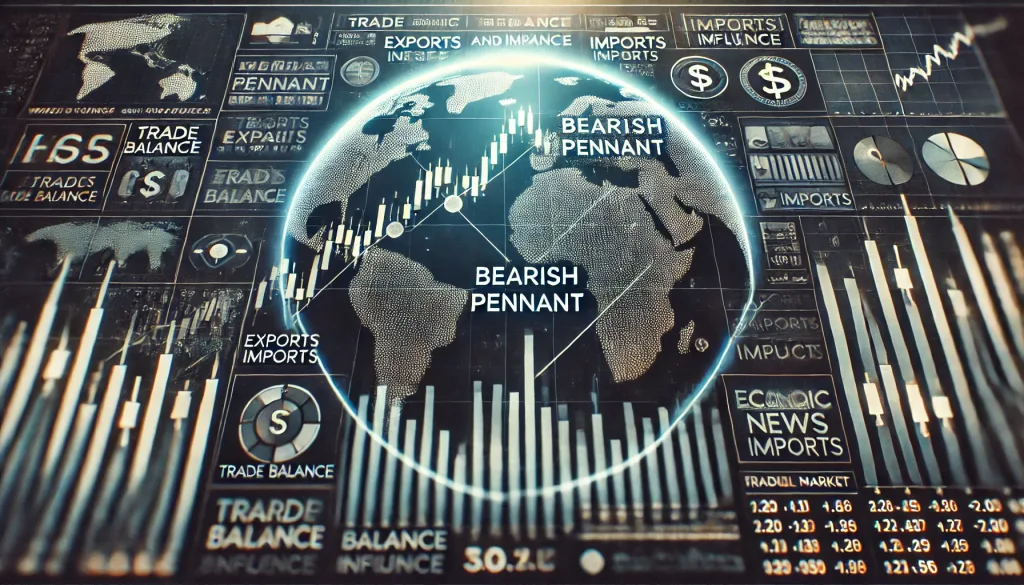The Hidden Forces Behind a Bearish Pennant: What Trade Balance Has to Do With It

Why Most Traders Miss the Big Picture Ever had a trade go south faster than a budget airline’s in-flight meal service? You analyze the charts, spot a clean bearish pennant, place your trade with supreme confidence, and then—BAM!—price reverses. You’re left staring at your screen, questioning your existence.
Here’s the brutal truth: most traders only look at technicals, completely ignoring the macroeconomic forces that shape these patterns. One of the biggest hidden factors behind a bearish pennant? Trade balance. Understanding this overlooked relationship can give you a real trading edge.
What’s a Bearish Pennant? (And Why It’s Not Just a Pretty Flag)
A bearish pennant is a continuation pattern that forms after a sharp downward move (the flagpole). It’s characterized by a small, symmetrical consolidation phase before price breaks down again. Think of it like a boxer catching his breath before delivering another knockout punch.
But here’s the kicker—not all bearish pennants lead to a breakdown. And if you’ve been burned by false breakouts before, you need to start looking beyond just the pattern itself.
Trade Balance: The Silent Market Mover
The trade balance (exports minus imports) tells you whether a country is a net seller or buyer of goods and services. A trade deficit (more imports than exports) weakens a currency, while a trade surplus strengthens it.
Now, why does this matter for bearish pennants? Because currency pairs don’t move in a vacuum! If you’re trading a pair where one country’s trade deficit is ballooning, that currency will naturally weaken, reinforcing the bearish pennant’s downward breakout.
Underground Secrets: The Trade Balance Playbook for Bearish Pennants
1. Follow the Trade Balance Reports Like a Hawk
Countries release their trade balance reports monthly. Here’s how you use them:
- If a country reports a larger-than-expected trade deficit, its currency will likely weaken. If the currency is already forming a bearish pennant, this adds confirmation for a continuation downward.
- If the trade balance unexpectedly improves, be cautious. The bearish pennant might fail due to newfound currency strength.
???? Pro Tip: The U.S. trade balance report has a direct impact on USD pairs. The same applies to other major economies like the EU, Japan, and China.
2. Pair It with Fundamental Triggers
Not all trade balance reports are created equal. Combine them with:
- Interest rate decisions: A central bank hiking rates with a worsening trade deficit? Expect a bloodbath.
- Inflation data: High inflation + trade deficit = accelerated currency weakness, boosting the bearish pennant breakdown.
- Geopolitical events: Tariffs, sanctions, and trade wars make trade balance figures even more impactful.
3. Compare Currency Strength Using the Trade Balance Differential
Let’s say you’re trading EUR/USD and spot a bearish pennant. Check both the EU and U.S. trade balance figures:
- If the Eurozone trade balance is improving while the U.S. trade balance is worsening, the pattern could fail.
- If both the EU and U.S. show weak trade balances, look at which is worse—this will help determine the dominant trend.
???? Advanced Ninja Move: Compare two countries’ trade balances using historical trends. If one economy consistently outperforms the other in trade, that long-term bias can reinforce bearish pennant setups.
Real-World Example: How This Played Out in 2023
In March 2023, the USD/JPY formed a textbook bearish pennant. Many traders jumped in, expecting a collapse. But here’s what most didn’t see:
- Japan’s trade deficit narrowed significantly due to a surge in exports.
- The U.S. trade deficit ballooned due to rising imports.
The result? The bearish pennant failed spectacularly, trapping traders in a painful short squeeze. Those who understood trade balance data dodged the trap—and even flipped bullish for massive gains.
The Bearish Pennant + Trade Balance Formula for Success
- Spot the pattern: Identify a clean bearish pennant setup.
- Check the trade balance: Compare the latest figures for the countries involved.
- Confirm with fundamentals: Interest rates, inflation, and news headlines should align.
- Monitor currency strength: Weigh the trade balance differential.
- Time your entry: Wait for trade balance data to drop if it’s near the release date—don’t get caught in a false breakout!
Final Takeaway: Stop Trading Blindly!
Next time you see a bearish pennant, ask yourself: What’s the trade balance telling me? Most traders miss this key macro factor, which is exactly why it gives you an edge. Combine technicals with fundamentals, and you’ll start spotting moves before they happen.
For deeper insights and real-time trade balance reports, check out StarseedFX’s latest economic indicators and stay ahead of the game.
—————–
Image Credits: Cover image at the top is AI-generated
PLEASE NOTE: This is not trading advice. It is educational content. Markets are influenced by numerous factors, and their reactions can vary each time.

Anne Durrell & Mo
About the Author
Anne Durrell (aka Anne Abouzeid), a former teacher, has a unique talent for transforming complex Forex concepts into something easy, accessible, and even fun. With a blend of humor and in-depth market insight, Anne makes learning about Forex both enlightening and entertaining. She began her trading journey alongside her husband, Mohamed Abouzeid, and they have now been trading full-time for over 12 years.
Anne loves writing and sharing her expertise. For those new to trading, she provides a variety of free forex courses on StarseedFX. If you enjoy the content and want to support her work, consider joining The StarseedFX Community, where you will get daily market insights and trading alerts.
Share This Articles
Recent Articles
The GBP/NZD Magic Trick: How Genetic Algorithms Can Transform Your Forex Strategy
The British Pound-New Zealand Dollar: Genetic Algorithms and the Hidden Forces Shaping Currency Pairs
Chande Momentum Oscillator Hack for AUD/JPY
The Forgotten Momentum Trick That’s Quietly Dominating AUD/JPY Why Most Traders Miss the Signal
Bearish Market Hack HFT Firms Hope You’ll Never Learn
The One Bearish Market Hack High Frequency Traders Don't Want You to Know The

